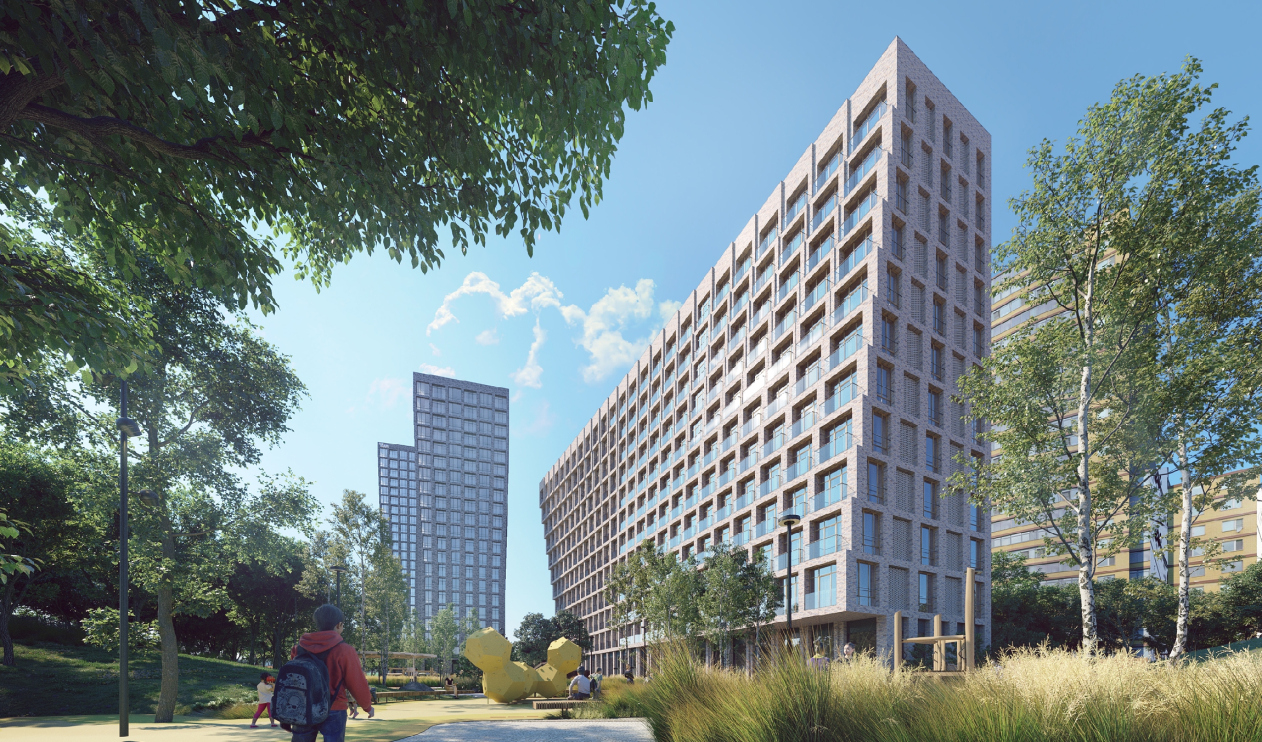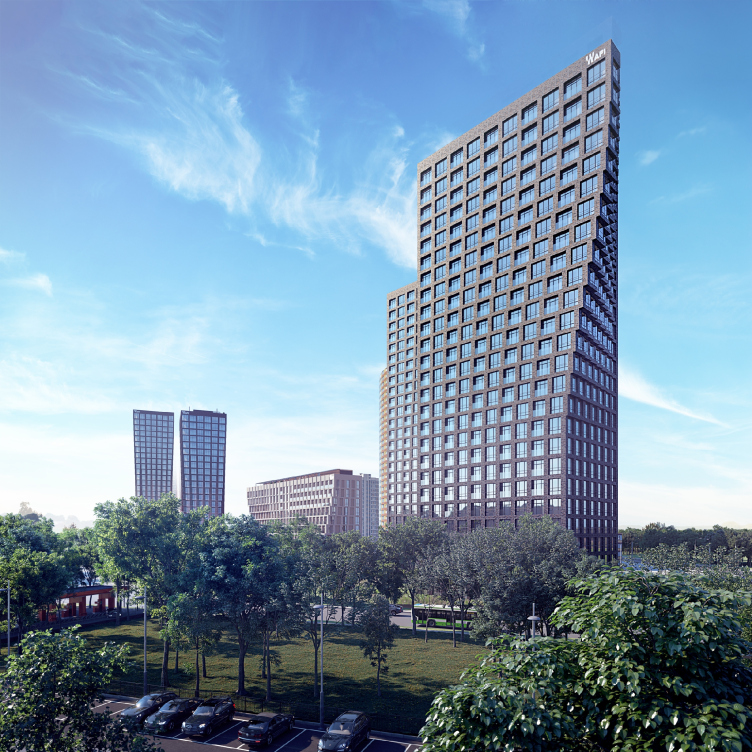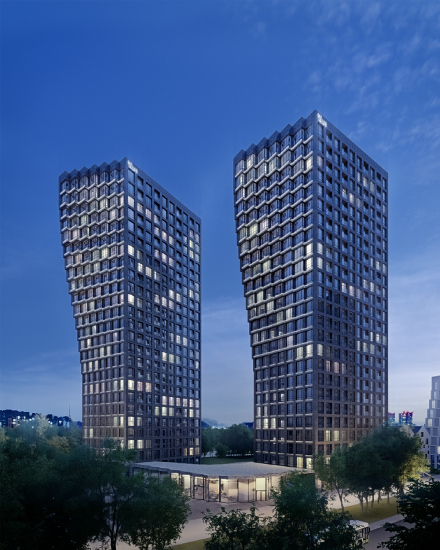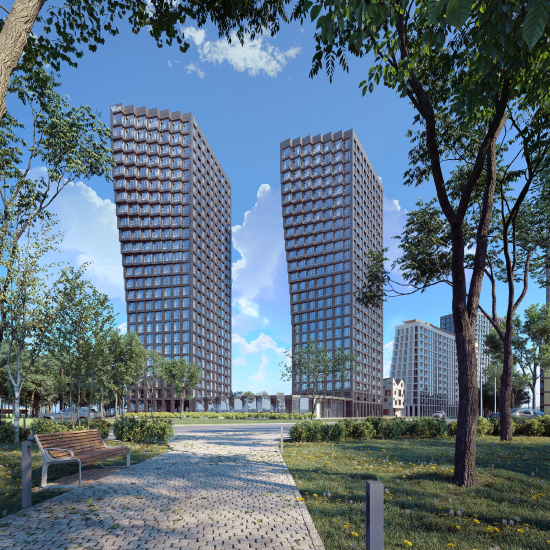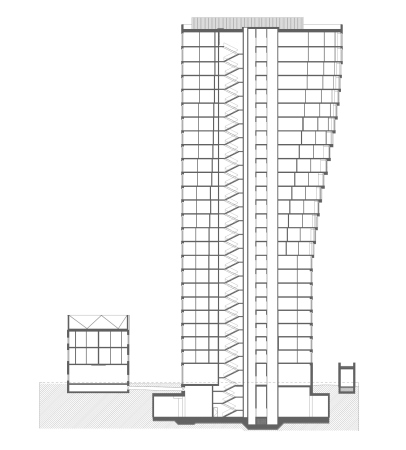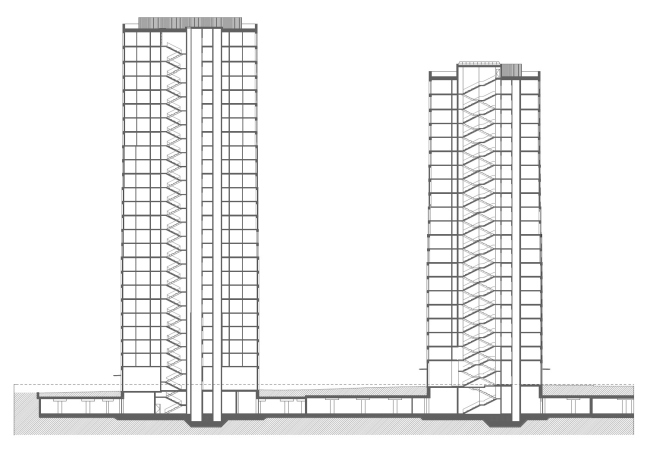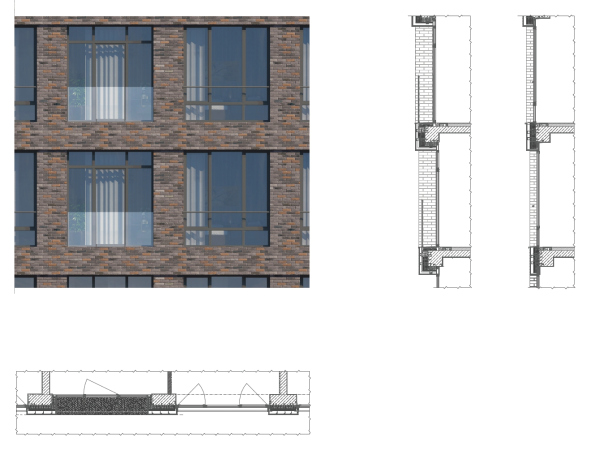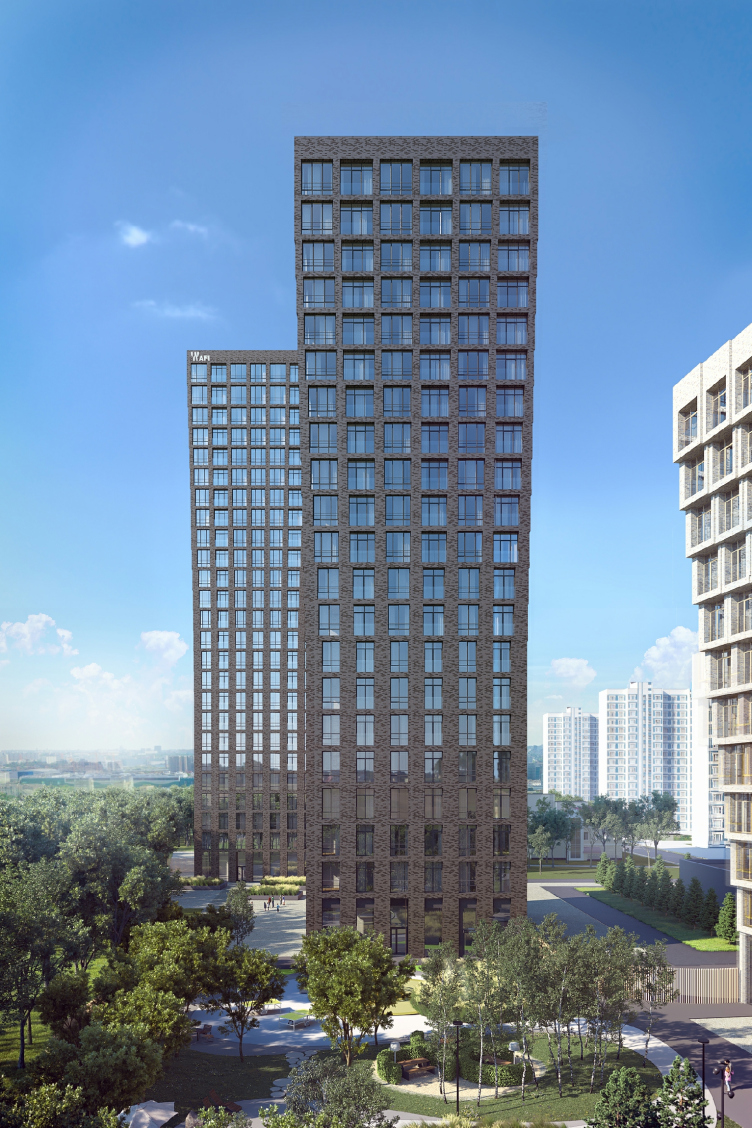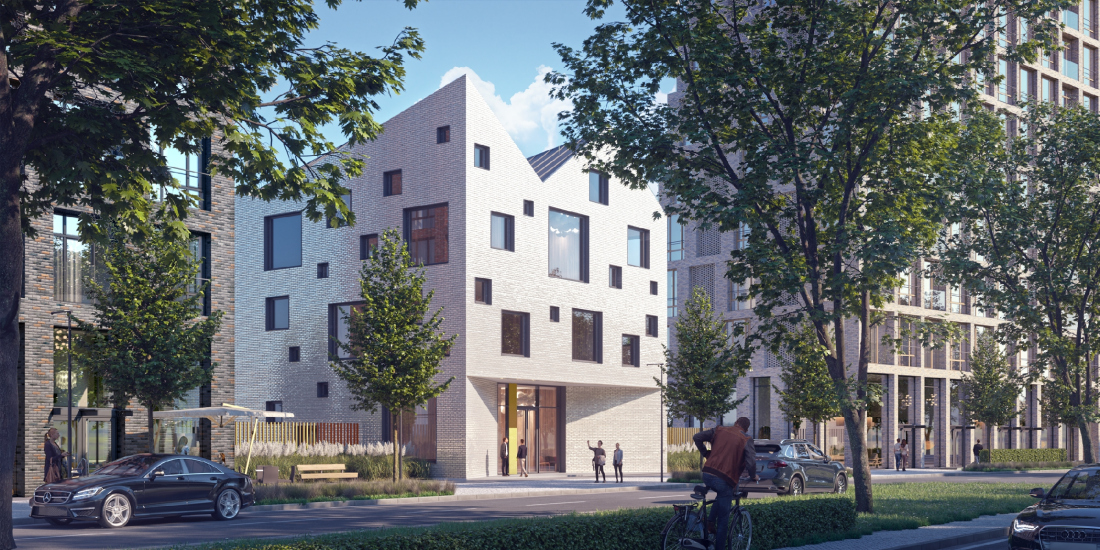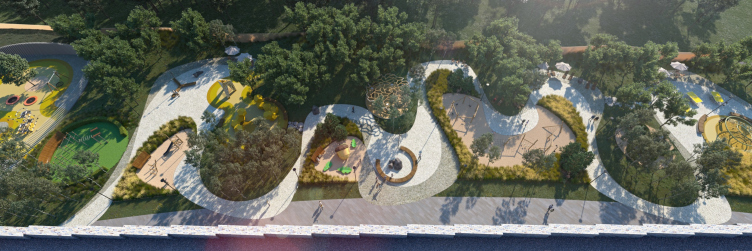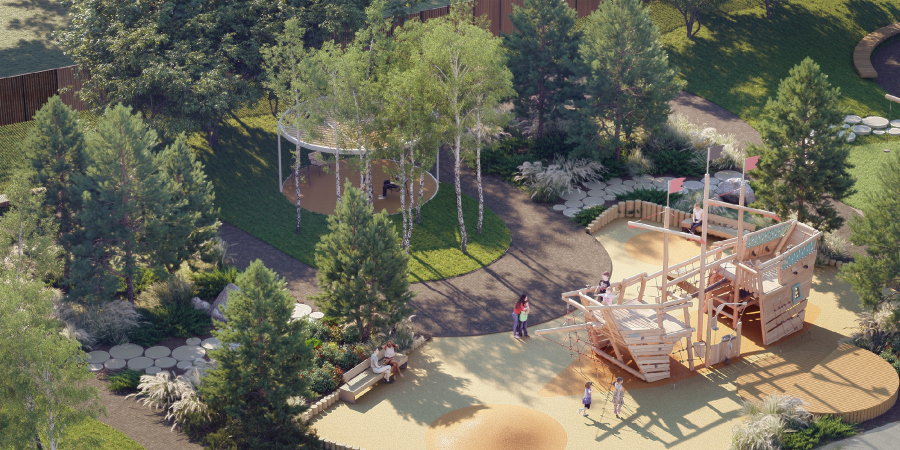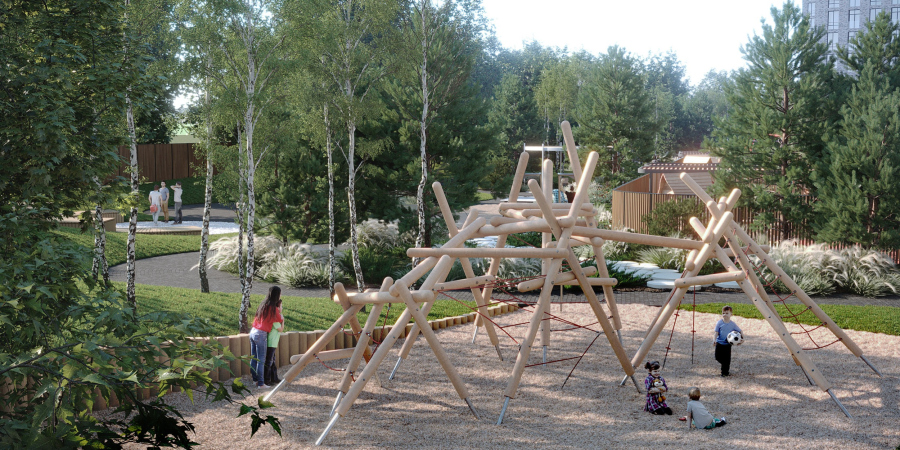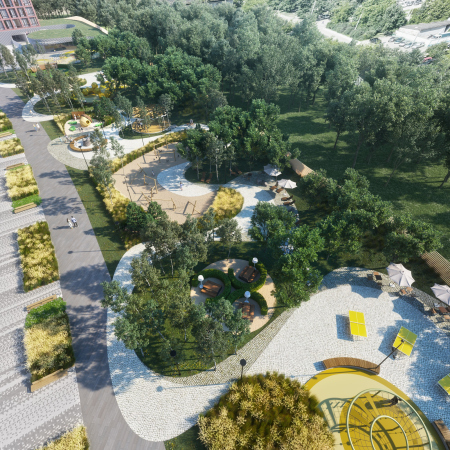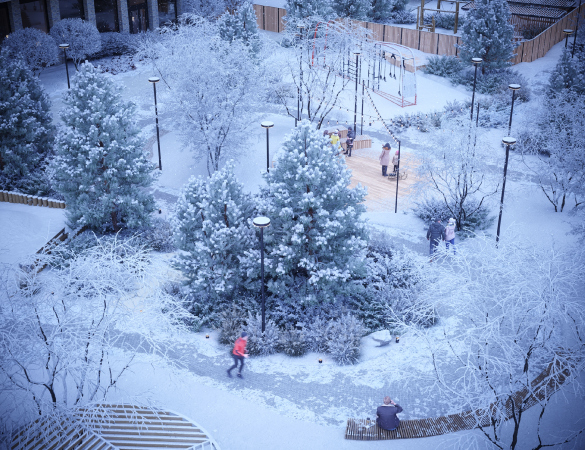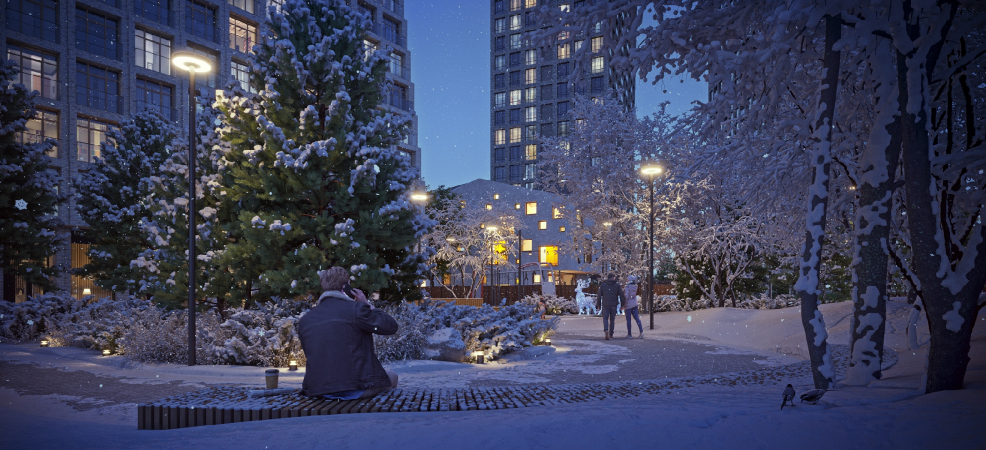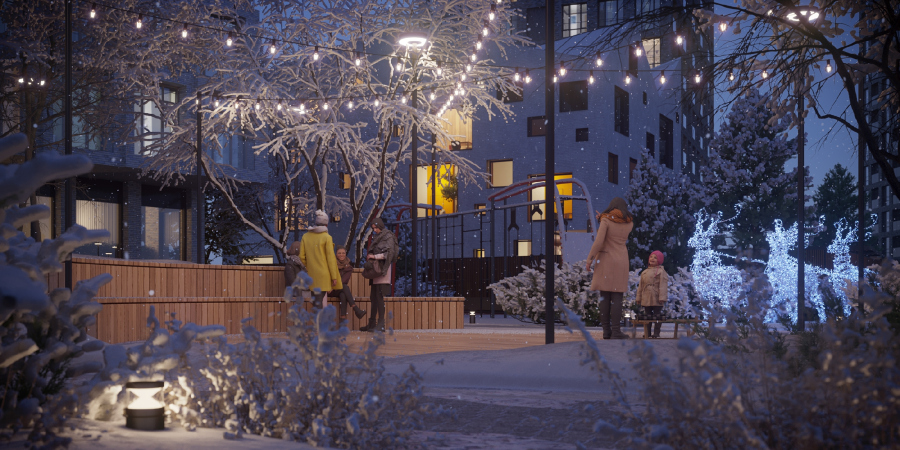The land site is rather large – 3 hectares – and elongated. It stretches diagonally, from northwest to southeast, between the Akademika Chelomeya and Arkhitektora Vlasova streets. On the side of Akademika Chelomeya Street, it is curbed by residential houses with urban infrastructure, cafes and shops in the first floors – partly because of this, the buildings of AFI PARK Vorontsovsky, whose lower tiers also will include shops, cafes, drugstores, and boutiques, gravitate gravitate towards this side of the territory, while from the opposite side, along the southeast border, stretches a green private yard, separated from the Vlasova Street by a fence. The layout idea is supported by an about 4-meter height drop: the northwest part of the territory not only adjoins the busier city street, but is also situated higher relief-wise, while the green strip corresponds to the smooth slope.
The master plan. AFI Park Vorontsovsky residential complex
Copyright: © ADM
Thus, the six volumes – five residential buildings from 12 to 25 stories high, and the kindergarten building – are lined up along Chelomeya Street. The composition of volumes inside the complex and even their very plastique are designed in such a way as to open up as many as possible panoramic views of the Vorontsovsky Park. Nearest to the park are two dark brick houses with bold recognizable silhouettes, looking like sails. This is the topmost quality housing here that provides the best views. Along the street, there is a 12-story “slab” house of light-colored brick. The space between the “sails” and the “slab” is occupied by a three-story kindergarten. The site is completed by two brick towers of a more austere silhouette. In their bottom parts, the “sail” houses are complemented by a stylobate of a complex shape with a zigzagging outline on the plan, which responds to the rounding of the land site. The stylobate will host shops and a restaurant with a terrace on the roof.
The overview from the side of Arkhitektora Vlasova Street. AFI Park Vorontsovsky residential complex
Copyright: © ADM
The dramatic silhouettes of the “sail” houses have quite a functional rationale. Due to the fact that the Vorontsovsky Park lies not directly beneath the windows but a little diagonally to the left, the houses in their upper parts make a twist, crumbling into bay windows, so as to ensure the maximum amount of panoramic views of the park. The bay windows stand out further and further, forming a dramatic line of the corner that looks as if it had been “pulled aside”. From a distance, it looks like a smooth curve, but from a close range you can see the ledges of individual modules. The relief of these “drawn” bay windows looks particularly interesting when viewed from the ground.
The finish, consisting of brown bricks with multicolored inclusions in combination with wide windows reaching to the floor with dark-gray sashes, gives the houses a certain “loft” look, but the rigorous loft grid is only used in the bottom floors. From the tenth floor up, dynamic twists and turns begin. The form takes on an illusion of agility of a cascade, combined with clear-cut cell structure – the sophisticated design of the whole, where each ledge is different from the preceding one, upon closer inspections turns out to be algorithm-based and predictable, because the main underlying principle is subjugated to consecutive logic.
The relatively small height of the “slab” house is determined by the insulation requirements of the neighboring buildings, while its elongated configuration called for a livelier plastique. Eventually, the 12-story house ended up being the most dynamic element in the complex: from the side of the yard, it is based on a spiral motion, and the facade looks as if it was rocking – one upper corner reaches out to the right, and the “antagonist” corner on the other end reaches out to the left. The resulting shape is slightly reminiscent of a propeller blade, and, it must be noted, that the whole of it, just as the plastique of the towers, is formed by the bay windows and the protruding cells of the apartments. Wherever their steps get wider at the bottom and narrower at the top, each apartment gets a small open-air balcony with a glass barrier; there is a cantilevered structure above the first floor. From the side of the yard, the house becomes a plastique event, a visual “hub” of sorts, which connects the two north towers with the two south ones. However, its outer facade, which faces the city, unlike the yard one, is rigorous and pristine, because it “holds” the street line.
View from the yard to the low-rise building. AFI Park Vorontsovsky residential complex
Copyright: © ADM
The sails and the slab essentially present two different typologies. Still another variant is presented by the towers that close the site from the opposite side. They are faced with the same dark brick as the “sails”, thus flanking the light-colored slab. Due to the fact that the tower do not directly contact any bright accents in the surrounding city space, their silhouette is more reserved, yet the facades still have some certain dynamics about them. In the top part of the facades, the windows are larger, glass is more abundant, and the brick grid is finer, while in the bottom part, on the other hand, the piers are thicker and more numerous. Curiously, this effect picks up momentum gradually, the houses opening up smoothly, a little bit like treetops. Accordingly, the floor space of the apartments gets bigger as well – I have an urge to call it “penthouse gradient”, carefully drawn by the architects in the plans, reflected in the facade patterns. Since the silhouettes of the towers gradually grow wider towards the top, the architects jokingly call them “wineglass” houses.
A front view of the “Wineglass” house. AFI Park Vorontsovsky residential complex
Copyright: © ADM
There are plans for equipping all of the houses with smart electronic systems that will be available for the residents via a mobile application from any point on the globe.
The complex also includes a kindergarten, whose imagery is significantly different from that of the residential houses. Its three-story building faces the Akademika Chelomeya Street, standing between the group of “sail” houses and the “slab” house. The asymmetric and differently sized square windows are reminiscent of Swiss cheese; the light-cream color of the walls brings up associations with a lump of sugar, and the pitched roofs bring in a note of North-European coziness, and a game element, which is just the thing for a kindergarten. To some extent, the volume of the kindergarten looks like the antipode of the “moving” and “growing in front of our eyes” plastique of the residential houses, as if it were one of the “old” houses that survived into the present amidst the new development. Partially, this is the effect that the architects wanted to create, based on the conviction that city space looks better when it is diverse scale- and typology-wise, looking a bit like a historical town that was naturally formed over different historical epochs. Without historical stylization, of course.
The welcoming glass lobby and the perspective portal of the entrance demonstrate transparency, unusual for such a facility. The first floor from the side of the yard is still more transparent: a broad stained glass window underneath the cantilever provides an opportunity for looking out to the yard from the inside, up to complete immersion.
The landscaping project is based on the specifics of the site, and is aimed at providing the residents with two main things that are deemed necessary in a modern housing complex: safety and diversity.
Top view of the yard. AFI Park Vorontsovsky residential complex
Copyright: © ADM
The spiral path winds among workout spaces, playgrounds, and pergolas, “quiet” and “noisy” places, connecting the elements of the elongated yard into a single whole and creates diversity of viewing angles and impressions. Jogging and cycling infrastructure is also provided.
The outdoor furniture, which forms cozy little corners for talking and contemplation, the quaint paths of round stones, and the thought-out lighting are meant to make the yard attractive at any time of the year, and suitable for the recreation of residents of all ages. The “club” atmosphere, set by the architecture, is observed in all parts of the complex.
In 2020, the architects completed the P stage – the complex is already in construction.
